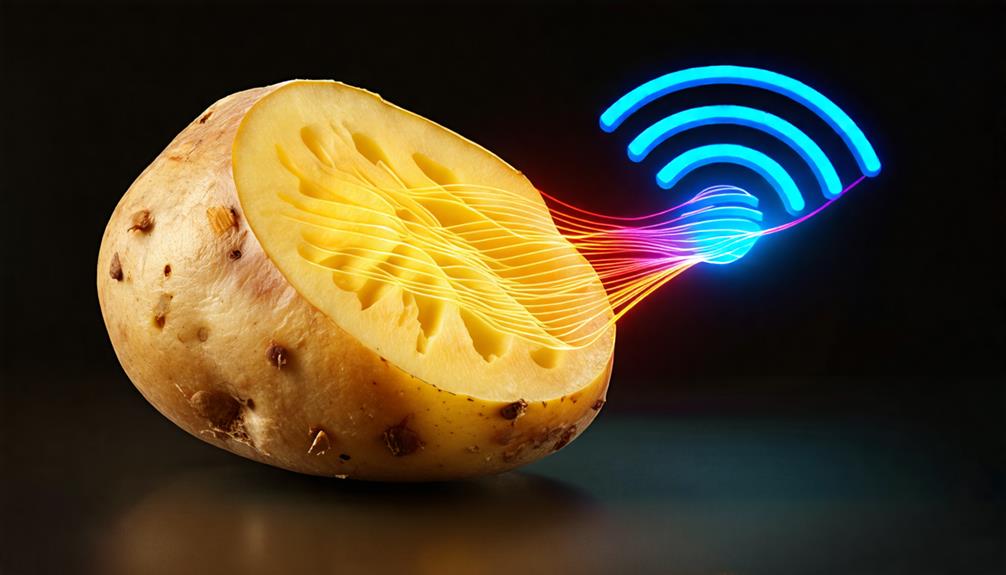You might not think of potatoes as high-tech tools, but they're proving to be surprisingly useful in the world of wireless connectivity. These humble tubers have an uncanny ability to absorb and reflect Wi-Fi signals, making them valuable assets in testing and optimizing wireless networks. It's not just a quirky coincidence; there's solid science behind why potatoes are so effective in this role. As you ponder the possibilities, you'll find that this unexpected application of potatoes is just the tip of the iceberg in a fascinating exploration of signal behavior and innovative testing methods.
Key Takeaways
- Potatoes have high water content, allowing them to effectively absorb and reflect Wi-Fi signals.
- The dielectric properties of potatoes closely match those of human tissues, making them ideal for Wi-Fi testing.
- Boeing used over 20,000 pounds of potatoes to simulate human passengers in aircraft Wi-Fi signal tests.
- Potatoes help identify weak spots in cabin signal coverage, improving overall Wi-Fi performance in airplanes.
Understanding Wi-Fi Signal Behavior

Immerse yourself in the world of Wi-Fi signals, where radio waves interact with their environment in ways that can make or break your connection. As you navigate this invisible landscape, you'll find that various materials can absorb, reflect, or refract Wi-Fi signals, impacting their strength and coverage.
Surprisingly, potatoes play a unique role in this domain. Their high water content and specific chemical composition make them excellent mimics of human bodies when it comes to interacting with Wi-Fi signals. Engineers have discovered that potatoes' dielectric properties closely match those of human tissues, making them valuable tools for studying signal behavior.
This insight helps optimize Wi-Fi technology and improve connectivity in challenging environments. By understanding how potatoes and other materials affect radio waves, engineers can identify weak spots and enhance your overall Wi-Fi experience, ensuring better connections in various settings.
Potato Properties for Signal Testing
Three key properties make potatoes ideal for Wi-Fi signal testing: their high water content, unique chemical composition, and dielectric characteristics that mimic human tissue.
These properties allow potatoes to absorb and reflect Wi-Fi signals similarly to human bodies, making them an effective substitute in testing scenarios.
Engineers have taken advantage of this similarity, using potatoes to simulate human passengers in aircraft Wi-Fi tests. For example, Boeing utilized over 20,000 pounds of potatoes to identify weak spots in Wi-Fi connectivity.
This innovative approach simplifies data collection and reduces costs for engineers.
The Journal of Food Science confirms that potatoes' dielectric properties closely match those of humans, further validating their use in signal testing.
Applications in Aviation Technology

Building on the success of potato-based signal testing, let's explore how this innovative approach has revolutionized Wi-Fi technology in the aviation industry.
Boeing's SPUDS project has transformed in-flight connectivity across various aircraft models. By using potatoes to absorb and reflect Wi-Fi signals, engineers have:
- Identified weak spots in cabin signal coverage
- Enhanced signal reliability throughout the aircraft
- Improved passenger experience on major Boeing models
- Developed more efficient testing methodologies
This creative use of potatoes in aviation technology hasn't only streamlined the testing process but also led to significant improvements in Wi-Fi performance.
The project's success demonstrates the potential for unconventional solutions in engineering challenges. As a result, you can now enjoy better connectivity on Boeing's 777, 747-8, and 787 Dreamliner aircraft.
This innovative approach may inspire similar practical solutions in other industries, potentially reshaping how we approach signal testing and optimization.
Conclusion
You've discovered an unexpected ally in Wi-Fi technology: the humble potato.
By harnessing its unique properties, you're able to simulate human tissue and test signal behavior in confined spaces.
This innovative approach isn't just for show; it's revolutionizing connectivity in aviation and beyond.
As you continue to explore this potato-powered solution, you'll reveal new possibilities for enhancing wireless performance and improving user experiences across various industries.
Who knew spuds could be so tech-savvy?

Leave a Reply